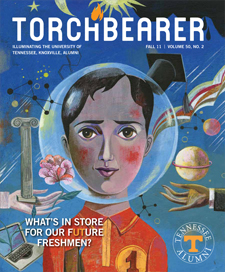Sure, a flying car that folds up into a briefcase and robotic housekeepers would be nice. And maybe an industry built on some kind of high-tech “sprockets” could boost our strained economy.
Alas, we don’t live in the world of The Jetsons, and it’s unlikely we will anytime soon. So what does the future hold? More specifically, what does the future hold for the baby born this year who will ultimately become John (or Joanna) Q. Student at UT Knoxville eighteen or nineteen years from now?
It’s a lofty question, and there are no easy answers. In fact, it’s pretty much a guessing game—unless you have a time machine (if so, please share!).
Sci-fi puns aside, looking ahead toward UT Knoxville’s future—and the future of our children—is a serious matter, and UT leaders, researchers, and experts have some plans and ideas about what life will be like when the newborns of 2011 become the freshmen of 2030.
What kind of institution will UT Knoxville be when the students first climb the Hill? How will society work for those students in terms of communication and new technology? What research currently conducted at UT Knoxville will affect the lives of our students and others?
Step into our time machine, and let’s find out.
Planet of the Vols

What lies over the horizon for future UT students? Zach Ward, seen here at 3, hopes to one day don his own Tennessee jersey as a student-athlete. He lives in Seymour with his parents, Joey and Shelley Ward.
If all goes according to plan, UT Knoxville should be one of the top twenty-five research institutions in the nation by the year 2030.
“We will expect students to perform at a high level,” says Chancellor Jimmy G. Cheek, who launched the Top 25 initiative following former Governor Phil Bredesen’s challenge to the university during his final term. “We will not only have a Top 25 institution, but we’ll have Top 25-caliber people here.”
Regardless of rankings, however, Cheek says that the ultimate goal is to create a better university for students, the community, and the state. One of the primary steps is improving the physical campus, which is already under way.
“In twenty years, we should have a campus that has a physical presence that we can be proud of,” says Provost Susan Martin. “Updating the campus will attract students and faculty.”
Martin argues that excellent faculty are key to recruiting and retaining students. A stronger faculty will build better academic programs and attract stronger students. The same will convince those students to stick around and successfully graduate with a degree. In turn, Martin says recruiting strong faculty will require “better support to conduct research, improved salaries, and state-of-the-art facilities for learning and research.”
Also, the students of the future will enjoy more encouragement and support to graduate within four years.
“Before the current economic downturn, families didn’t feel the pressure to make sure students graduated in four years,” Martin says. “But that’s all changed, and we have to make it happen.”
Unsurprisingly, technology will be essential in helping students stay on track to graduate on time, and UT Knoxville is already working hard to implement resources that track student progress in their majors and flag those students who aren’t making progress. As a result, students who need extra help won’t be lost in the mix, and the university will be able to more actively engage with those students.
Of course, the students of 2030 will be part of an all-new generation with totally different expectations, especially for life outside the classroom.
“The student body will be a microcosm of society at large,” says Tim Rogers, vice chancellor for student affairs. “We’ll have far more diversity on campus, with students desiring an even greater immersion in other cultures.”
Stephanie Bohon, an associate professor in the department of sociology, says the campus will have a larger Latino population, and more women will receive advanced degrees.
“UT will benefit from more diverse students and faculty,” Bohon says. “We could close the gap in racial disparity and become a model in creating a campus where students feel safe.”
Rogers says that students will more actively demand increased study abroad opportunities, more environmental initiatives, and more service projects. In other words, the Volunteer spirit will be alive and well and owned by students for years to come.
“Students will guide us into the future by challenging us socially and technologically,” Rogers says. One unique social and technological challenge is communication.
“Because young people are growing up with communication that’s more technologically driven, we’re going to add more meeting places on campus, including in residence halls to enhance their opportunities for interpersonal communication.” he says.
Close Encounters
 It’s hard to imagine that face-to-face interaction will ever go out of style. However, as we already know, technology and communication go hand in hand. So, it’s not a far leap to think technology will be an absolute necessity to the way the students of 2030 communicate with family, friends, and even professors.
It’s hard to imagine that face-to-face interaction will ever go out of style. However, as we already know, technology and communication go hand in hand. So, it’s not a far leap to think technology will be an absolute necessity to the way the students of 2030 communicate with family, friends, and even professors.
While there will most certainly be some form of social networking—whether it is Facebook, Twitter, or some other platform—there may likely be new technology that will take the place of e-mail and texting. These and other advances in technology may also branch out and take an even stronger hold on everyday life.
To help grasp the technological advances that may exist by the year 2030, Jack Dongarra, University Distinguished Professor of Computer Science, references one of sci-fi writer Arthur Clarke’s laws of prediction, which states, “Any sufficiently advanced technology is indistinguishable from magic.”
To us in 2011, it may very well seem magical when we read Dongarra’s description of technological advances that he believes may become the norm in the future.
“Computers will be embedded in everything,” he says. “There won’t be desktops or laptops, keyboards or mice. Output will be displayed in 3-D on a surface, or maybe even on the retina of the eye.”
Intelligent computers will be able to detect changes in the environment and adjust themselves accordingly. Everything will be wireless and connected to the Internet. Information will no longer be digitally stored in a local machine but will live online in “the cloud.”
When it comes to education and technology, Dongarra and Ben Bates, professor of journalism and electronic media, agree that the students of 2030 will have many more options available as a result of technological advances.
“Learning and teaching will be much more flexible,” says Bates.
“Schools will find they can offer a mix of courses—online and traditional—to accommodate different types of learners.”
The professors go a step further to say that the same course could be taught online at different levels, depending on a student’s rate of learning and skills they may have already acquired.
“Computers may adapt to the level of the individual, pouring information at either a faster or slower rate,” Dongarra says. “And grades will be assigned accordingly.”
While study abroad will always be a popular option for students, Bates also sees the possibility and value of having internationally collaborative classes. For example, students at UT Knoxville could take an engineering course taught in collaboration with a class in a school in China.
“This would certainly broaden the range of information available to our students,” he says. “And developing the reputation of a Top 25 institute will allow us to have these kinds of opportunities.”
Dongarra says that, in turn, being able to offer these kinds of opportunities “brings better things to the university, by drawing the attention of better students and higher-profile faculty and possibly bringing in funding for research.”
To Boldly Go
 In addition to making learning and communication more fluid, the increasing use of portable devices like cell phones and laptops allows researchers like UT geography professor Shih-Lung Shaw to study human movement on many levels, from the transportation dynamics of Beijing to the shopping habits of a man in Iowa City.
In addition to making learning and communication more fluid, the increasing use of portable devices like cell phones and laptops allows researchers like UT geography professor Shih-Lung Shaw to study human movement on many levels, from the transportation dynamics of Beijing to the shopping habits of a man in Iowa City.
Shaw is a leading figure in the field of geographic information systems (GIS), in which researchers use geographic data and other information (gleaned from static documents, like census figures, and portable devices) to study human movement and transportation. By outlining when and where people travel and patterns that emerge, researchers can work to develop solutions for such problems as traffic congestion, homeland security, and the spread of infectious diseases.
But technological advancement may be too much of a good thing. Shaw acknowledges that one major stumbling block in his field is the fact that advances in electronics and mobile devices have led to more and quicker changes in human behavior, making it more difficult to conduct long-range planning for things like road transportation.
“We start the planning stage ten, fifteen, twenty years ahead,” Shaw says. “But are we going to move in the same ways twenty years from now? Probably not.”
While Shaw and other geographers are working on large-scale population observations, architects are also examining the problems of movement, energy, and transportation, albeit often on the individual and community levels. According to Ken McCown, chair of the landscape architecture program, energy expenditures, an aging population, and rising health problems are going to force architects and urban planners to rethink the way communities and homes are designed.
In terms of health, the promotion of exercise and walking through the use of sidewalks, green spaces, and well-designed business areas will be crucial. Currently, experts are debating the best way to enact these improvements, McCown says.
“Architecture can promote health by working with other disciplines like nursing, landscape architecture, public health, and community building,” he says. “It’s time for architects to collaborate with other disciplines and advance communities in this new era.”
A New Hope
 While it’s fun to try on speculative spectacles and think about the future, the ultimate concern at UT Knoxville is building a better university for today’s and tomorrow’s students, whether they graduate next year or start their college career in 2030.
While it’s fun to try on speculative spectacles and think about the future, the ultimate concern at UT Knoxville is building a better university for today’s and tomorrow’s students, whether they graduate next year or start their college career in 2030.
“At the end of the day, students are why we’re here,” Cheek says. “Our business is the education of young men and women and ensuring they receive a high-quality education.”
“We have to assess what we do, why we do it, and whether it’s effective,” Rogers says. “We need to listen to feedback and learn from it. If we want world-class students and world-class faculty and staff, we have to present a world-class, culturally enriched experience for the campus.”
Without a doubt, the university’s Top 25 challenge will be an ongoing journey.
“We’ll continually revisit the Top 25,” Martin says. “And if we achieve it, what’s next? That’s a great problem to have. We need to be nimble enough to change and be the very best UT we can be.”
—Roger Hagy, Jr. (’07), Cassandra J. Sproles, and Meredith McGroarty,
with illustrations by Olaf Hajek


3 comments
I totally disagree with the route UT is currently taking. This push to make it a top 25 public university confirms that it is not a quality institution at this time.
In order to achieve the goal, a goal based on some artificial standards set by a weekly magazine that few people read, the university will abandon other less costly efforts that made UT what it was when I was there a unique place that provided a quality education at a modest price.
And by the way, how does a $300 million dollar student center fit into this?
I believe we already have top 25 caliber people. I guess have a higher opinion of the University than the author.
Hugh Galbreath ’61
Just wanting to say nice post.
Comments are closed.